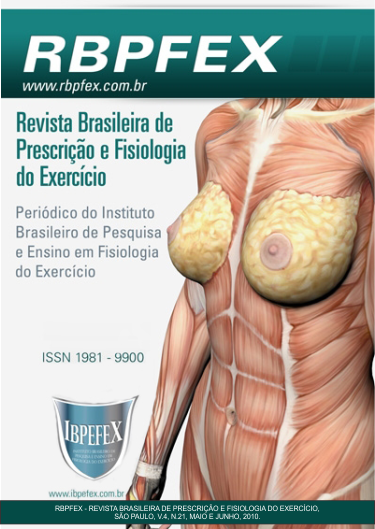Effect of a single section of force exercise 60% of 1RM on the blood pressure of trained individuals of the masculine sort
Abstract
The Arterial hypertension it’s a chronic disease and often asymptomatic. Therefore, reducing the pressure values even in normotensives subjects is an important factor to minimize the risk of heart disease. One of the strategies used to reduce blood pressure is a regular practice of physical exercise and between then endurance exercises. Thus the objective of this study was to evaluate the acute effect of a single session of exercise resisted at 60% of 1RM over the blood pressure. This study had the participation of 18 male subjects (28.7 ± 2.8 years) with experience in power training and was developed as follows: after the test of 1RM in the exercises: Leg press, straight supine, knob; Flexor and Development Bureau, the individuals were submitted to a single training session, where they held three sets of 12 repetitions for each exercise proposed, and the blood pressure measured by the auscultatory method in moments before and after exercise up to 60 minutes. For the statistical treatment was used the ANOVA for repeated measures followed by post-hoc test of Bonferroni. The one-hour period ofmonitoring the blood pressure after the exercise showed significant variations in the moments immediately after and 5 minutes after exercise, at the end of an hour, although no significant, there was a decreased blood pressure on the rest. Thus, it concluded that a single session of endurance exercise was able to promote changes on blood pressure of the individual, although not significant, was sufficient to promote reduction in BPcompared to BPof rest.
References
-Baster, T.; Baster-Brooks, C. Exercise and Hypertension. Reprinted from Australian Family Physician. Australian. Vol. 34. Num. 6. 2005. p. 419–424.
-Bermudes, A.M.L.M.; Vassallo, D.V.; Vasquez, E.C.; Lima, E.G. Monitorização ambulatorial da pressão arterial em indivíduos normotensos submetidos a duas sessões únicas de exercícios: Resistido e Aeróbico. Arquivos brasileiros de cardiologia. São Paulo. Vol. 32. Num. 1. 2003. p. 57-64.
-Brum, P.C.; Forjaz, C. L. M.; Tinucci, T.; Negrão, C.E. Adaptação agudas e crônicas do exercício físico no sistema cardiovascular. Revista paulista de educação física. São Paulo. Vol. 18. Num. esp. 2004. p. 21-31.
-Carrington, C.A.; White, M.J. Exercise-induced muscle chemorefley modulation of spontaneous baroreflex sensitivity in man. Journal of physiology. Vol. 536. Num. 3. 2001. p. 957-962.
-Chavez, C.R.M.M.; Oliveira, C.Q.; Britto, J.A.A.; Elsa, S.M.I.C.G. Exercício Aeróbio, Treinamento de Força Muscular e Teste de Aptidão Física Para Adolescentes com Fibrose Cistica: Revisão de literatura. Revista brasileira de saúde materno infantil. Rio de janeiro. Vol. 7. Num. 3. 2007. p. 245–250.
-Focht, B.C.; Koltyn, K.F. Influence of resistence exercise of different intensities an state anxiety and blood pressure. Medicine and science in sports end exercise. Vol. 31. Num. 3. 1991. p. 456-463.
-Forjas, C.L.M.; Cardoso Junior, C.G.; Araújo, E.A.; Costa, L.A.R.; Teixeira, L.; Gomides, R.S. Exercício físico e hipertensão arterial: riscos e benefícios. Revista da sociedade Brasileira de Hipertensão. São Paulo. Vol. 9. Num. 3. 2006. p. 104–112.
-Halliwill JR. Mechanisms and clinical implications of post-exercise hypotension in humans. Exerc Sport Sci Rev. Num. 29. 2001. p. 65-70.
-Lima, V.; Caetano, J. A.; Soares, E.; Santos, Z.M.S.A. Fatores de risco associados a hipertensão arterial sistêmica em vítimas de acidente vascular cerebral. Revista Brasileira de Promoção da Saúde. Fortaleza. Vol. 19. Num. 3. 2006. p. 148–154.
-MacDonald, J.R. Potential causes, mechanisms, and implications of post exercise hypotension. Journal of human hypertension. Vol. 16. Num. 4. 2002. p. 225-236.
-MacDougall, J.D.; Tuxen, D.; Sale, D.G.; Moroz, J.R.; Sutton, J.R. Arterial blood pressure response to heavy resistente exercicse. Journal of Applied Physiology. Vol. 58. Num. 3. 1985. P. 785-790.
-Mediano, M.F.F.; Paravidino, V.; Simão, R.; Pontes, F.L.; Polito, M.D. Comportamento subagudo da pressão arterial após o treinamento de força em hipertensos controlados. Revista Brasileira de Medicina do Esporte. Niterói. Vol. 11. Num. 6. 2005. p. 337–340.
-Monteiro, M.F.; Sobral Filho, D.C. Exercício físico e controle da pressão arterial. Revista Brasileira de Medicina do Esporte. Niterói. Vol. 10. Num. 6. 2004. p. 513 –516.
-O ́Connor, P.J.; Bryant, C.X.; Veltri, J.P.; Gebhardt, S.M. State anxiety and ambulatory blood pressure folloning resistence exercise in femeles. Medicine and science in sports and exercise. Vol. 25. Num. 4. 1993. p. 516-521.
-Polito, M.D.; Simão, R.; Senna, G.W.; Farinatti, P.T.V. Efeito hipotensivo do exercício de força realizado em intensidades diferentes e mesmo volume de trabalho. Revista Brasileira de Medicina do Esporte. Niterói. Vol. 9. Num. 2. 2003. p. 69–73.
-Rolim, N.P.L.; Brum, P.C. Efeito do treinamento físico aeróbio na hipertensão arterial. Revista da Sociedade Brasileira de Hipertensão. São Paulo. Vol. 1. Num. 8. 2005. p. 35–37.
-Simão, R.; Fleck, S.J.; Polito, M.; Monteiro, W.; Farinatti, P. Effects of resistancetraining intensity, volume, and session format on the postexercise hypotensive response. Journalof Strengthand Conditioning Research. Vol. 19. Num. 4. 2005. p. 853–858.
-Ward, M.E. Dilation of rat diaphragmatic arterioles by flow and hypoxia: roles of nitric oxide and prostaglandins. J Appl Physiol. Num. 86. 1999. p. 1644-1650.
Authors who publish in this journal agree to the following terms:
- Authors retain the copyright and grant the journal the right of first publication, with work simultaneously licensed under the Creative Commons Attribution License BY-NC which allows the sharing of the work with acknowledgment of the authorship of the work and initial publication in this journal.
- Authors are authorized to enter into additional contracts separately for non-exclusive distribution of the version of the work published in this journal (eg, publishing in institutional repository or book chapter), with acknowledgment of authorship and initial publication in this journal.
- Authors are allowed and encouraged to post and distribute their work online (eg, in institutional repositories or on their personal page) at any point before or during the editorial process, as this can bring about productive change as well as increase impact and impact. citation of published work (See The Effect of Free Access).






